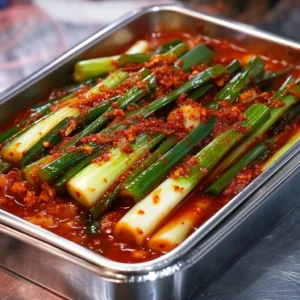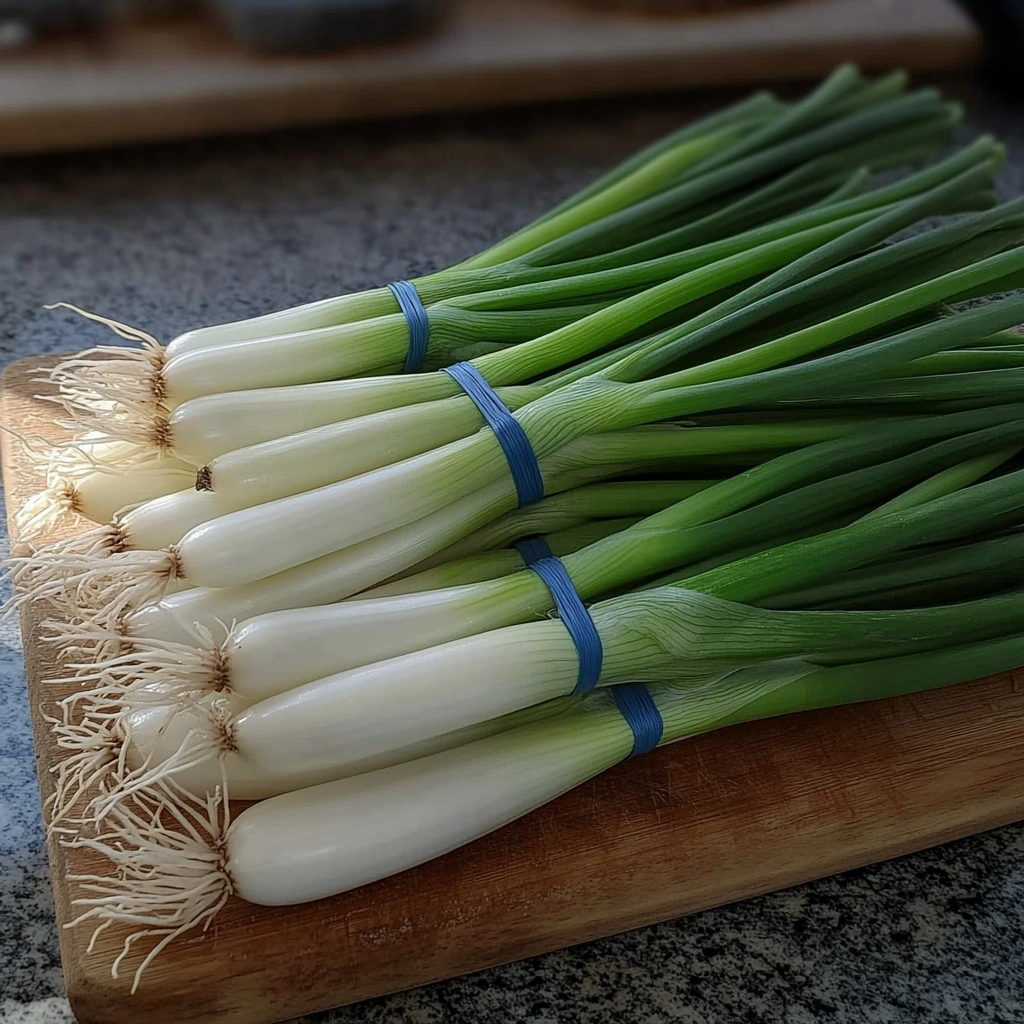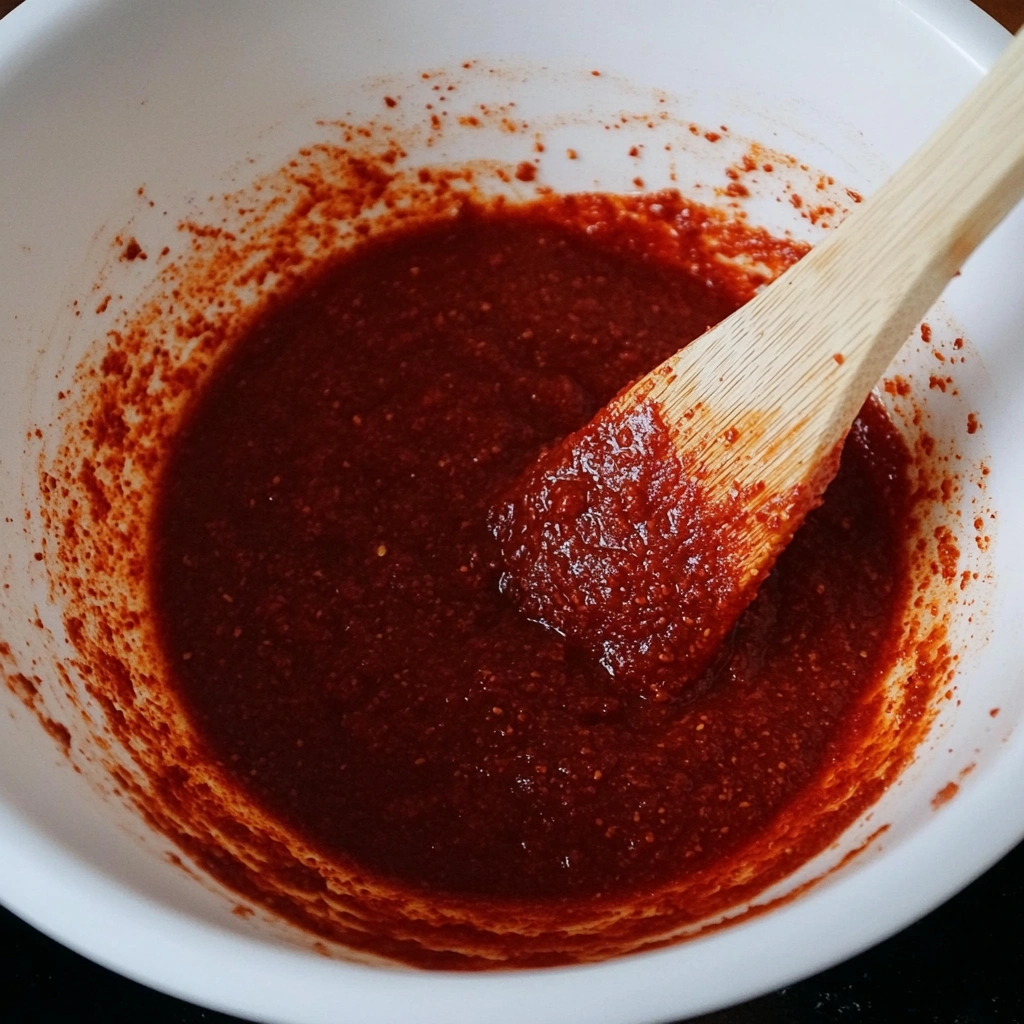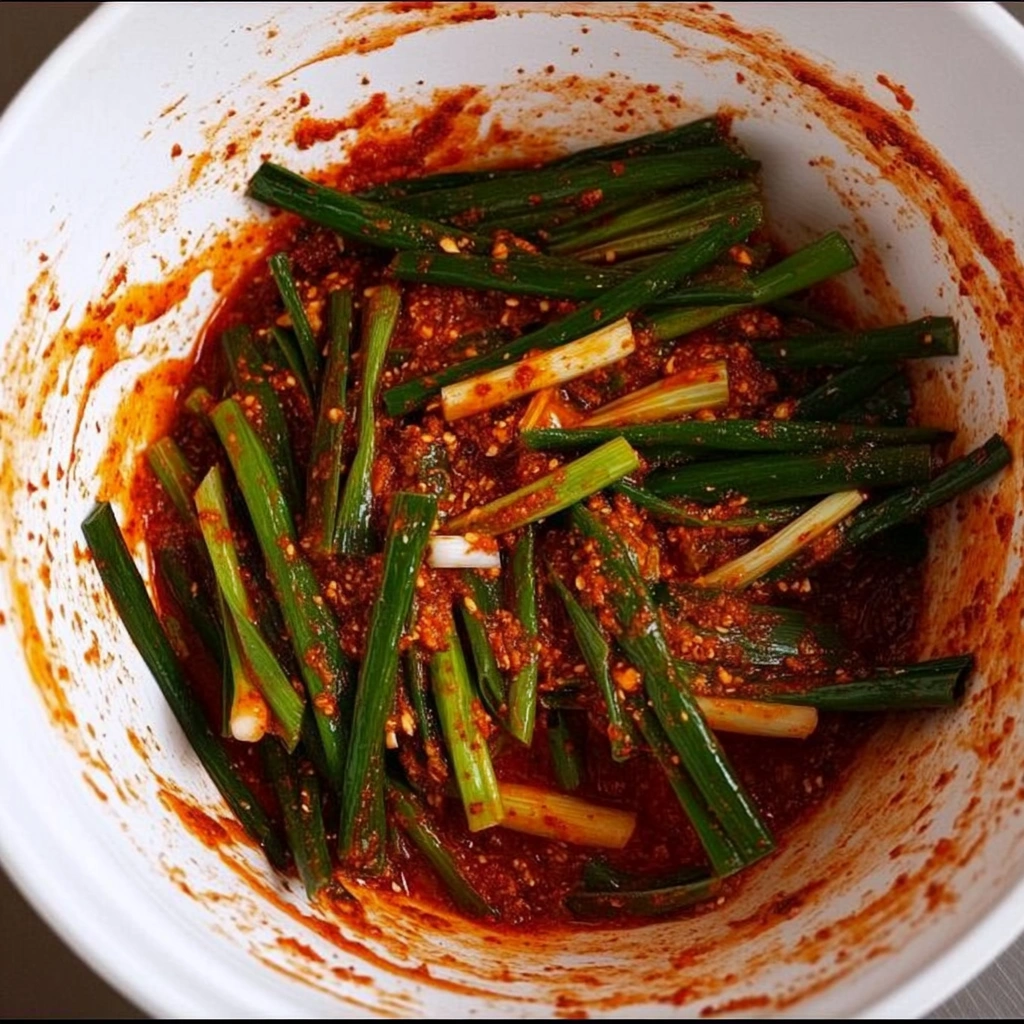Green onion kimchi recipe lovers, you’re in for a treat. This spicy, crunchy, and super aromatic Korean side dish — known as Pa-kimchi (파김치) — is easier to make than traditional napa cabbage kimchi and packed with bold flavor in every bite. If you’re craving a kimchi that’s fast to prep, full of attitude, and loaded with fermented goodness, you’ve found your match.
Unlike baechu kimchi, this version skips the garlic, radish, and ginger — but doesn’t skip the punch. This green onion kimchi recipe uses only a few core ingredients like fish sauce, gochugaru (Korean hot pepper flakes), and a simple rice porridge base. The result? A deeply savory and flexible dish you can serve fresh or fermented, with rice, stews, grilled meats — or even on its own.
Table of Contents
Ingredients & Preparation for the Best Green Onion Kimchi Recipe
What You Need to Make Authentic Green Onion Kimchi
To master this green onion kimchi recipe, you’ll only need a handful of ingredients. It’s simpler than napa cabbage kimchi but just as flavorful. Here’s what you need:

Green Onion Kimchi Recipe
Ingredients
- 3 lbs green onions trimmed
- 1 cup fish sauce or soy sauce/miso mix
- 1 ½ cups gochugaru
- ¼ cup glutinous rice flour
- 2 tbsp sugar
- 2 –3 tbsp gochujang optional
Instructions
- Wash, trim, and salt green onions.
- Make glutinous rice porridge.
- Mix in gochugaru, sugar, and optional gochujang.
- Combine paste and onions. Store in airtight container.
- Ferment for 5–7 days (room temp) or 2 weeks (fridge).
- 3 pounds green onions (look for thinner ones if possible)

- 1 cup fish sauce (use soup soy sauce for vegetarian version)
- ¼ cup glutinous rice flour (aka “sweet rice flour”)
- 2 tablespoons sugar (white or brown)
- 1½ cups gochugaru (Korean red pepper flakes)
This minimalist approach makes green onion kimchi ideal for quick kimchi-making at home..
How to Prep Ingredients Before Mixing
- Trim & Wash Green Onions: Remove the roots and any damaged outer layers. Rinse thoroughly with cold water 2–3 times.
- Soak in Fish Sauce: Toss the onions in a large bowl with the fish sauce and let them sit for 1 hour, flipping every 20 minutes to salt evenly.

- Make the Rice Paste:
- Combine rice flour and 3 cups of water in a saucepan.
- Heat over medium-high while stirring until it bubbles.
- Add sugar and stir until the mixture becomes slightly translucent (around 1 minute).
- Let it cool completely before adding gochugaru.

This thickened porridge becomes the flavor base of your green onion kimchi recipe.
Once the porridge is cool and mixed with chili flakes, it’s time to move on to combining everything.
Mixing, Fermenting & Storing Your Green Onion Kimchi Recipe
How to Mix the Green Onion Kimchi Paste
Now that your seasoning paste is ready, it’s time to put it all together and bring this green onion kimchi recipe to life. Here’s how to do it step-by-step:
- Add the cooled porridge to the fish sauce mixture in your bowl.
- Mix in the gochugaru (Korean red pepper flakes) using a wooden spoon. Let the mixture sit for about 30 minutes. This lets the chili flakes absorb the moisture and swell up into a thick paste.

- Toss in the green onions. Use your hands (wear gloves if needed) to gently coat each stalk with the chili paste. Make sure every part is well covered — from the white bulbs to the leafy greens.
This step is where the flavors begin to truly come together. The rich, spicy paste clings to the tender onions, setting the stage for fermentation.
How to Ferment & Store Green Onion Kimchi the Right Way
Once your green onions are coated:
- Pack them tightly into a clean airtight container or glass jar.
- Press down to eliminate air pockets — air is the enemy of good fermentation.
- Seal and let it sit:
- For fast fermentation: Leave the container at room temperature for 5–7 days.
- For slower, longer fermentation: Store it in the refrigerator. It takes about 2 weeks to reach full fermentation.
You’ll know it’s ready when it smells slightly sour and the onions have softened while still retaining a bit of crunch.
Properly stored in the fridge, this green onion kimchi recipe will stay flavorful and edible for several weeks. The flavor even deepens with time.
Simple Green Onion Kimchi Recipe vs. Traditional Styles
Simple Green Onion Kimchi Recipe: Why It’s So Beginner-Friendly
If you’re just starting out in Korean cuisine, this green onion kimchi recipe is the perfect place to begin. Why? It skips many of the complex steps and long ingredient lists you’d find in traditional napa cabbage kimchi.
Here’s what makes the simple version easier:
- Fewer Ingredients: You don’t need garlic, ginger, radish, or chives.
- Shorter Prep Time: No need to soak or brine cabbage overnight.
- Less Messy: Mixing long, slender onions is quicker and less bulky than dealing with cabbage leaves.
- Flexible Seasoning: It still delivers that classic fermented kimchi flavor but without the fuss.
This quick recipe makes pa-kimchi accessible to anyone — even if you’ve never made kimchi before.
Traditional Green Onion Kimchi: What Makes It Authentic?
In Korea, especially in the southern provinces like Jeolla, pa-kimchi has deep cultural roots. Traditional styles use:
- Extra aromatics like garlic, ginger, and sometimes raw seafood-based ingredients for richer umami.
- Hand-bundled onions neatly tied for aesthetics and serving convenience.
- Local green onions that are thinner, more pungent, and ideal for fermentation.
If you’re aiming for that authentic green onion kimchi recipe, you’ll want to:
- Use Korean thin green onions if you can find them.
- Stick to anchovy fish sauce or fermented shrimp for deeper flavor.
- Allow a slower, more gradual fermentation process for a stronger aroma and depth.
💡 Looking for bold flavor additions? Check out our Mango Habanero Hot Sauce Recipe — a fun twist if you’re experimenting with fusion flavors in your kimchi!
What to Eat with Green Onion Kimchi
Everyday Meals That Pair Beautifully with Green Onion Kimchi
Green onion kimchi isn’t just a side dish — it’s a game-changer. Its bold, spicy, and slightly sour flavor lifts up nearly any meal. If you’re wondering what to eat with green onion kimchi, here are some of the best everyday pairings that bring out the best in your pa-kimchi:
- Steamed White Rice: The most classic combination. The simplicity of rice balances the strong flavor of kimchi.
- Korean Soybean Paste Stew (Doenjang-jjigae): A warm, savory stew that matches kimchi’s umami depth.
- Grilled Meats (Samgyeopsal or Bulgogi): The acidity of kimchi cuts through fatty meats perfectly.
- Fried Eggs or Omelets: For a quick breakfast or lunch, add green onion kimchi on the side of eggs for a savory kick.
- Noodles (Cold or Hot): Whether it’s spicy cold noodles or a hot bowl of ramyeon, green onion kimchi brings complexity and crunch.
Creative and Modern Ways to Enjoy Green Onion Kimchi
If you’re feeling adventurous, take your green onion kimchi recipe further. These modern mashups are a fun way to use leftovers or to serve kimchi in new ways:
- Kimchi Quesadillas: Swap out napa cabbage kimchi for green onion kimchi for a lighter, zippier twist.
- Kimchi Pancakes (Kimchijeon): Use chopped green onion kimchi in the batter — it’s spicier and crisper.
- Kimchi Grilled Cheese: Yes, it works. The heat and tang pair wonderfully with gooey cheese.
- Buddha Bowls: Add a few strands of pa-kimchi on your grain bowls for bold color and flavor.
- Ramen Toppings: Garnish instant or homemade ramen with sliced green onion kimchi for a fermented punch.
The intense aroma and spicy-sour bite of green onion kimchi means you don’t need a lot to make an impact. Just a small portion on the side can elevate your plate.
Authentic Green Onion Kimchi Variations Across Korea
Regional Differences in Pa-Kimchi Preparation
Green onion kimchi, or pa-kimchi, is deeply rooted in Korean culinary tradition — but like many beloved dishes, it varies by region. If you’re exploring the authentic green onion kimchi recipe, it helps to know how flavor profiles shift depending on where you’re cooking.
Here’s how different parts of Korea prepare their version of green onion kimchi:
- Jeolla Province in Southwestern Korea is famous for its bold and spicy green onion kimchi. This version uses extra gochugaru, lots of anchovy fish sauce, and occasionally ground fermented shrimp for deeper flavor. The green onions are often tied into bundles after seasoning.
- Gyeongsang Province: Their kimchi leans saltier and more pungent. It may include more fish-based umami like myeolchi-aekjeot (fermented anchovy sauce).
- Seoul and Gyeonggi Areas: These central regions tend to go lighter on spice. Some recipes use a bit of sugar or apple puree to soften the bite.
- Jeju Island: Islanders use local scallions and seafood-based sauces, such as galchi-aekjeot (hairtail fish sauce), giving the kimchi a unique oceanic taste.
No matter the region, the essence of green onion kimchi remains the same: spicy, aromatic, and sharp — but the details can make your batch truly local in flavor.
How to Spot Authentic Green Onion Kimchi
Wondering whether a recipe you’re following is truly authentic? Here are some indicators that you’re creating something genuine:
- Whole green onions are used — not chopped. This gives the final kimchi its iconic layered presentation.
- Unlike napa cabbage kimchi, there’s no need for garlic or ginger.
- A fish sauce base like anchovy or fermented shrimp is common, though vegetarian versions can swap in soy sauce or kelp stock.
- Bundled and layered green onions in the kimchi jar are typical of older, more traditional methods.
Some recipes may adapt to Western ingredients (like trimming thick onions or adjusting spice levels), but the heart of pa-kimchi is in the balance of spicy heat, salt, and fermentation.
Green Onion Kimchi Without Fish Sauce
Why Make Green Onion Kimchi Without Fish Sauce?
Traditional green onion kimchi recipes often rely on fish sauce for their signature umami depth. But not everyone consumes seafood — whether for dietary, religious, or allergy reasons. That’s where the green onion kimchi without fish sauce variation comes in.
This version keeps all the bold, fermented tang of pa-kimchi while remaining fully vegetarian or vegan-friendly. It’s perfect for those seeking cleaner, plant-based alternatives without sacrificing traditional flavor.
Common reasons to skip fish sauce:
- Vegan or vegetarian diet
- Shellfish allergies
- Kosher or Halal dietary restrictions
- Reducing sodium from fermented fish products
By making just a few smart substitutions, you can still enjoy all the richness of Korean flavors.
Best Substitutes for Fish Sauce in Kimchi
If you’re making green onion kimchi without fish sauce, the goal is to replace the salty umami profile with a plant-based equivalent.
Here are the top options:
| Substitute | Why It Works | Usage |
|---|---|---|
| Soy Sauce (preferably Korean guk-ganjang) | Adds saltiness and mild umami | Use 1:1 ratio for fish sauce |
| Tamari | Gluten-free and savory | Best for sensitive diets |
| Miso Paste + Water | Fermented depth similar to fish | Mix 1 tbsp miso with 2 tbsp water |
| Seaweed Broth (Kelp or Kombu) | Delivers oceanic flavor without seafood | Steep 1 sheet in hot water, use as liquid base |
| Coconut Aminos | Sweeter, lower sodium | Good for paleo or soy-free diets |
When replacing fish sauce, remember to taste your kimchi paste before mixing it with the onions. Adjust salt levels to ensure proper fermentation and flavor.
How to Adjust the Recipe
To make a fish-free version of the green onion kimchi recipe, here’s what you’ll tweak:
- Replace 1 cup of fish sauce with ¾ cup soy sauce or seaweed broth + miso combo.
- Keep all other steps and ingredients the same.
- Ferment as usual — no additional changes needed.
This results in a still-pungent, deeply flavorful kimchi that fits your plant-based lifestyle.
Green Onion Kimchi Recipe with Gochujang
What Is Gochujang and Why Use It in a Green Onion Kimchi Recipe?
Gochujang is a staple ingredient in Korean cooking — a deep-red fermented chili paste made from chili powder, glutinous rice, fermented soybeans, and salt. It’s known for its bold, umami-rich taste with hints of sweetness and spice.
Adding gochujang to your green onion kimchi recipe introduces a bold twist that enhances both flavor and texture. Unlike the traditional pa-kimchi which uses gochugaru alone (Korean chili flakes), gochujang adds a rich consistency and layered heat. The result is a slightly thicker, more luxurious paste that perfectly complements the sharpness of green onions.
Whether you’re updating a classic or experimenting with flavor, this green onion kimchi recipe with gochujang brings balance and depth — perfect for anyone craving a bold side dish with a modern edge.
How to Add Gochujang to Your Green Onion Kimchi Recipe
To infuse your green onion kimchi recipe with gochujang, you’ll follow the basic preparation steps but include this powerhouse chili paste in your kimchi porridge.
Extra Ingredients:
- 2 to 3 tablespoons gochujang (adjust to your spice level)
Modified Paste Instructions:
- Prepare the porridge using glutinous rice flour, water, and sugar as usual.
- Add gochugaru (Korean red pepper flakes) and let sit.
- While warm, stir in gochujang for better blending and depth of flavor.
- Combine with fish sauce (or a vegetarian alternative).
- Let the paste cool before mixing it with the green onions.
This method produces a vibrant red, slightly sweet and spicy kimchi paste that gives your green onion kimchi recipe a bold visual and flavor upgrade.
Serving Ideas for Gochujang Green Onion Kimchi
Wondering what to eat with green onion kimchi? This spicy, umami-packed green onion kimchi recipe with gochujang works best with savory or grilled dishes that can handle its flavor punch.
Here are perfect pairings:
- Bulgogi (Korean BBQ beef)
- Kimchi grilled cheese sandwiches
- Spicy grilled tofu or tempeh
- Korean fried chicken (classic or vegan)
- Bibimbap bowls
For more fusion ideas, try stirring chopped kimchi into:
- Kimchi pancakes (jeon)
- Kimchi fried rice
- Savory Korean soups and stews
Why This Version Works
This variation of the green onion kimchi recipe is perfect if you’re looking to elevate traditional Korean flavors with a modern twist. The gochujang adds umami and a rich, spicy-sweet note, making it versatile enough to enjoy on its own or as a bold side.
Green Onion Kimchi Ingredients
Essential Ingredients for Green Onion Kimchi Recipe
To make an authentic green onion kimchi recipe, you don’t need an overwhelming list of ingredients. In fact, that’s part of the beauty of pa-kimchi — it’s simple, clean, and lets the bold flavor of green onions shine through. Below is a detailed breakdown of the must-haves, along with optional additions to personalize your batch.
Core Ingredients
| Ingredient | Purpose |
|---|---|
| Green Onions (3 lbs) | The base of the recipe – pungent, crisp, and aromatic |
| Fish Sauce (1 cup) | Adds umami and saltiness |
| Gochugaru (1½ cups) | Korean red pepper flakes for heat and color |
| Glutinous Rice Flour (¼ cup) | Thickens the kimchi paste for better adhesion |
| Sugar (2 tbsp) | Balances the heat with mild sweetness |
| Water (3 cups) | To create the base rice porridge for the paste |
Optional Flavor Boosters
Want to take your green onion kimchi recipe to the next level? Add these:
- Gochujang: Use 2–3 tbsp for extra spice and depth
- Miso paste: For vegetarian-friendly umami richness
- Sesame seeds or oil: A nutty finishing note (added just before serving)
- Minced garlic: Optional, but common in some regions of Korea
Ingredient Sourcing Tips
- Green onions: In Korea, long, thin green onions are standard. In the U.S., look for firm, fresh scallions with minimal browning and vibrant green tops.
- Gochugaru: Use coarse ground for the best texture. Avoid standard chili powder.
- Glutinous rice flour: Sometimes labeled “sweet rice flour” — NOT the same as regular rice flour.
Ingredient Substitution Chart
| If You Don’t Have… | Try This Instead |
|---|---|
| Fish Sauce | Soy Sauce, Tamari, Seaweed Broth |
| Gochugaru | Aleppo pepper (milder), or Korean chili powder blend |
| Glutinous Rice Flour | Cooked white rice blended with water (as a last resort) |
This flexibility is one reason why the green onion kimchi recipe has become so popular — you can adapt it to your pantry and preferences while still maintaining authentic flavor.
Conclusion
By now, you’ve explored every angle of the green onion kimchi recipe — from traditional versions to vegan-friendly options and bold gochujang twists. Whether you’re new to Korean cuisine or an experienced fermenter, pa-kimchi is one of the most rewarding recipes to make at home.
Why? It’s fast to prepare, deeply flavorful, and endlessly adaptable. You can go classic with just fish sauce and gochugaru, or make it vegan with soy sauce and miso. Want spice? Add gochujang. Need a no-fuss side? Just serve it with hot rice or grilled protein.
Plus, the fermentation process means this kimchi gets better with time — transforming your kitchen into a flavor lab and your meals into something unforgettable.
So if you’ve been wondering whether now is the time to try your own green onion kimchi recipe, the answer is: yes. Dive in, mix it up, and taste the depth of Korean tradition with every bite.
for more recipes follow facebook and pintrest
FAQ
Simple Green Onion Kimchi Recipe
Simple Green Onion Kimchi Recipe
Q: What is the easiest green onion kimchi recipe for beginners?
A simple green onion kimchi recipe uses just a handful of ingredients: green onions, fish sauce (or soy sauce for vegetarians), gochugaru, sugar, and glutinous rice flour to make the paste. Toss everything together and store it in an airtight container to ferment. It’s quick, spicy, and ready to eat within a few days — no chopping or complicated prep requir
Traditional Green Onion Kimchi Recipe
Q: What makes a green onion kimchi recipe traditional?
A traditional green onion kimchi recipe follows the South Jeolla-style method — using whole green onions, fermented fish sauce, and a gochugaru-heavy paste. It doesn’t include ginger, radish, or garlic like napa kimchi does. This version is spicier and more aromatic, reflecting its regional roots in Korea.
What to Eat with Green Onion Kimchi?
Q: What dishes go well with green onion kimchi?
Green onion kimchi pairs well with warm steamed rice, Korean BBQ, grilled tofu, bibimbap, or noodle dishes like japchae. It can also be chopped into kimchi pancakes, kimchi fried rice, or even used as a topping for avocado toast.
Best Green Onion Kimchi Recipe
Q: What’s the best green onion kimchi recipe to try at home?
The best recipe balances umami, spice, and tang. Start with green onions, a well-fermented gochugaru paste, and fish sauce or a plant-based substitute. Let it ferment for 5–7 days at room temp, then chill. For extra flavor, try our gochujang variation — it’s rich, spicy, and beginner-friendly.
Authentic Green Onion Kimchi Recipe
Q: How can I make authentic green onion kimchi at home?
To make an authentic green onion kimchi recipe, use traditional Korean ingredients like gochugaru, fish sauce, and glutinous rice flour porridge. The green onions should remain whole and be fermented in bundles. Let them rest at room temperature for up to a week to develop that signature tang.
Green Onion Kimchi Without Fish Sauce
Q: Can I make green onion kimchi without fish sauce?
Absolutely. Swap the fish sauce with soy sauce, tamari, or miso paste + seaweed broth. This vegetarian green onion kimchi recipe still delivers deep flavor without the seafood — ideal for vegan or allergy-friendly diets.
Green Onion Kimchi With Gochujang
Q: What’s different about green onion kimchi with gochujang?
Adding gochujang creates a thicker, deeper paste with a mild sweetness. This variation elevates the standard green onion kimchi recipe by blending spice and umami for a bold, modern twist that pairs well with rice bowls and grilled dishes.
Green Onion Kimchi Ingredients
Q: What ingredients do I need for green onion kimchi?
You’ll need:
Green onions
Fish sauce (or substitute)
Gochugaru
Glutinous rice flour
Sugar
Water
Optional: gochujang, garlic, miso, sesame oil


1 thought on “Green Onion Kimchi Recipe: The Best 5-Step Pa-Kimchi Guide You’ll Love”
Comments are closed.